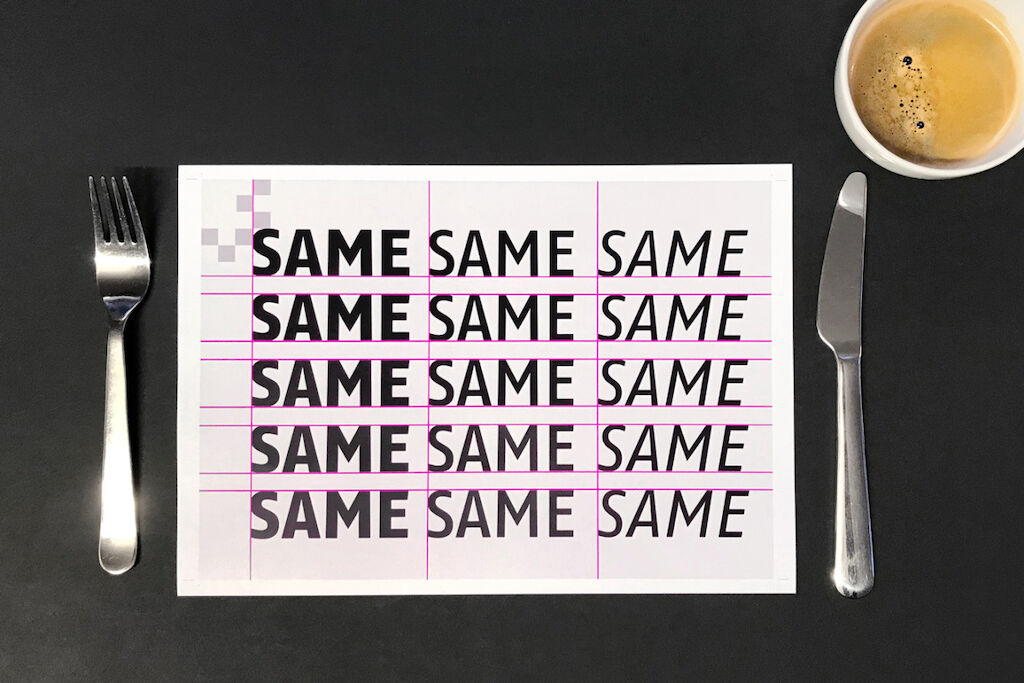We need to talk about a word that we as branding experts use a lot and employ frequently to justify decisions when working on or with a brand; a word whose meaning appears crystal clear to us at first, but is worth a closer look: consistency.
Who hasn’t heard phrases like “we must have a consistent brand experience” or “that’s particularly good because it’s consistent with our brand” during a brainstorming session, presentation, or board meeting? Often decisions are made in favor of consistency in form and appearance rather than for new experiences that seem unfamiliar but might fit the core of the brand perfectly.
The underlying dogma is easy: consistency = all good
I understand that brand managers are looking for traditional reference points in moments of decision-making. But dos-and-don’ts guidelines aiming to achieve a uniform brand experience simply don’t cut it on their own.
That’s why a closer analysis of this “sacred” term yields actionable insights. It requires precise definition and consideration on what it actually means for our daily work. And then there’s this other term, which sounds so similar but rarely attracts attention: coherence.
The difference between consistency and coherence
Let’s take a look:
Consistency comes from the Medieval Latin word consistentia, which means as much as uniformity or standing firm. Take for example the defined position of a brand’s logo that marks it as the sender of a message. Such a predefined rule aims to achieve formal uniformity across all communication.
Coherence has its roots in the Latin word cohaerentia, which describes a correlation or a connection between two things. An example from brand management would be when a brand that stands for seeking adventure features a free climbing event.
It’s important to notice the seemingly small but far-reaching difference here: while consistency describes the aspiration of uniformity, coherence merely means that there’s an overlap in regard to content.
Why we love talking about consistency
The next question is to what degree does an overlap in coherence exist? Are there enough matching associations and similarities between the two to result in something that can be called a coherent experience? Among many other factors, judging the degree of coherence requires comprehensive knowledge about the brand itself, its history and desired state in the future, specific target groups, context, etc.
As a result, it’s easier to turn to formal consistency than content-related coherence. In most cases, that’s what we end up doing. Consistency follows rules about what is right and what is wrong. These rules were put in place by people just like us. And that’s fine. But deciding whether something is coherent for a brand needs more than that. It requires associative thinking that goes beyond what strikes the eye. It needs discussion if not debate, cultural and contextual background, as well as deep-rooted implicit knowledge about the nature of a brand (also known as “gut feeling”) when it comes time to make a decision.
What this means for our daily work
To me, the relationship between consistency and coherence is as Peter Drucker said: “culture eats strategy for breakfast.” The best strategy won’t work if it doesn’t resonate with the company’s underlying culture or complement it. By the same token, all formal consistency is pointless if it doesn’t support a brand in terms of its content.
Don’t get me wrong: Consistency is not unimportant or to be neglected, but it has its dedicated place and function. It’s essential for creating recognizable design, tone of voice, and making a brand recognizable at first sight by users and consumers. But it’s no end in itself. If formal consistency becomes the single overarching goal in branding and marketing, it will be eaten for breakfast for sure as it provides no further value to the customer. Creating both a consistent and coherent brand experience is a challenge to everyone involved, from researchers to consultants to designers. It needs ongoing discussion and debate and can’t be done by simply looking it up in any guideline document. That’s often demanding — but always worth it.
_Andreas Fachner is brand strategist at MetaDesign Düsseldorf.
